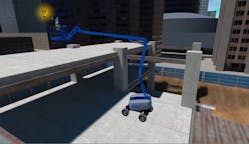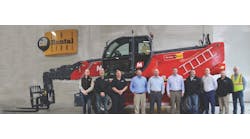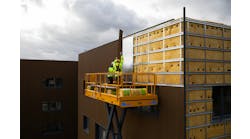Genie is bringing its training platform into the future with a new virtual reality component.
Developed as an add-on to Genie’s existing classroom and hands-on training programs, Genie VR training provides an opportunity for operators to use aerial equipment—and learn to avoid real-world hazards that cause the majority of jobsite accidents—from the safety of a virtual world.
The Genie VR training experience, debuted at the recent ARA Show, uses a specially programmed headset that allows operators to control a Genie Z-45 FE articulated boom lift in four training scenarios designed to assist with control familiarization and operation.
To develop the training experience, Genie engineers, product managers and trainers collaborated with a software company that is experienced in creating virtual reality programs for a variety of applications and industries, including defense flight simulation.
“In 2010—the same year that a college student died in a scissor lift tip-over accident while filming a football practice in high winds I helped develop and teach our first MEWP training course,” said Genie Training Director Scott Owyen. “The goal of the course was to help end users understand common hazards they could face when operating scissor lifts and boom lifts so they could learn how to avoid them and stay safe while working at height. Since then, we’ve continued to focus on offering training that advances safety in the industry. And, our new VR platform does just that
The Genie VR training experience includes four different activities, although Owyen says not all of them will be used for every class:
- Operations, which helps users gain familiarity with the lift’s controls;
- The Ghost Arena, which challenges operators to precisely position the machine to match a given outline;
- The Safety Gauntlet, a course that encourages users to navigate a virtual jobsite and avoid reallife hazards to collect trophies; and
- A Steel Erector simulator, which requires positioning the boom to weld steel beams onto a structure.
A specially programmed headset allows operators to control a Genie Z-45 FE articulated boom lift in four training scenarios designed to assist with control familiarization and operation.
While the VR experience is intended as an add-on to the train-the-trainer class, it could also be available for operator qualification training if requested, Owyen noted. However, the VR training will not be offered as a stand-alone class, or a substitute to in-person training.
“While VR training feels very realistic, it simply can’t replace that real-world experience,” said Owyen. “But, allowing someone to practice what they’ve learned in a classroom, before going up in a lift, not only makes what they’ve learned more memorable, it enhances safety. That’s because, in a virtual world, you can experience a catastrophe without actually getting hurt. And, because the brain thinks it actually happened, it is an incredibly emotional and impressionable way to learn.”
The visuals in Genie’s VR experience were developed by utilizing Genie CAD drawings, real world specs, performance characteristics, videos of equipment operating, and sound recordings of an actual Z-45 FE boom.
For the VR training, Genie chose headsets that are highly portable and offer superior graphics, as well as customized refresh rates that mirrors how we see things in real-life to reduce chances that a participant will experience motion sickness.
While many train-the-trainer courses take place at Genie’s training centers in Rock Hill, South Carolina; Burleson, Texas; and Bothell, Washington, training also often occurs at a user’s location.
“That might be out in the oil fields, underground in a salt mine, or any number of places with unreliable internet,” Owyen added.







